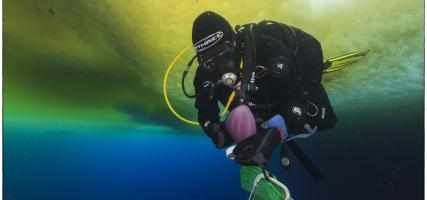
Recherche
Affiner les 91 résultats
, 2017 — The French Muséum national d’histoire naturelle vascular plant herbarium collection dataset. Scientific Data vol. 4, , p. 170016
ISSN
2052-4463
, septembre 2015 — Island life - classification, speciation and cryptic species of Pycnandra (Sapotaceae) in New Caledonia: Island Life of Pycnandra. Botanical Journal of the Linnean Society vol. 179, n° 1, p. 57-77
ISSN
00244074
, juin 2016 — DNA barcoding of malagasy rosewoods: Towards a molecular identification of CITES-listed Dalbergia species. PLoS One vol. 11, n° 6, e0157881
ISSN
1932-6203
, décembre 2016 — Gradual vs. abrupt reduction of carpels in syncarpous gynoecia: A case study from Polyscias subg. Arthrophyllum (Araliaceae: Apiales). American Journal of Botany vol. 103, n° 12, p. 2028-2057
ISSN
0002-9122, 1537-2197
, 2015 — Effects of heat on the germination of sclerophyllous forest species in the highlands of Madagascar. Austral Ecology vol. 40, n° 5, p. 601-610
ISSN
14429985
, juin 2016 — A taxonomic revision of the endemic New Caledonian genus Storthocalyx Baill. (Sapindaceae). Systematic Botany vol. 41, n° 2, p. 387-400
ISSN
03636445, 15482324
, septembre 2016 — The phylogenetic significance of fruit and trichome structures in Apiaceae subfamily Mackinlayoideae. Systematic Botany vol. 41, n° 3, p. 685-699
ISSN
03636445, 15482324
, octobre 2016 — Morphometrics and molecular phylogenetics of Angraecum section Dolabrifolia (Orchidaceae, Angraecinae). Plant Systematics and Evolution vol. 302, n° 8, p. 1027-1045
ISSN
0378-2697, 2199-6881
, 2015 — Achieving sustainable conservation in Madagascar: the case of the newly established Ibity Mountain Protected Area. Tropical Conservation Science vol. 8, , p. 367-395
, avril 2017 — Straddling the Mozambique Channel: molecular evidence for two major clades of Afro-Malagasy Schefflera (Araliaceae) co-occurring in Africa and Madagascar. Plant Ecology and Evolution vol. 150, n° 1, p. 87-108
ISSN
20323913, 20323921
, octobre 2016 — A taxonomic revision of Angraecum section Dolabrifolia (Orchidaceae, Angraecinae), with the description of a new species from Gabon. Phytotaxa vol. 280, n° 2, p. 81
ISSN
1179-3163, 1179-3155
, 2016 — The phylogenetic significance of fruit structural variation in the tribe Heteromorpheae (Apiaceae). Pakistan Journal of Botany vol. 48, n° 1, p. 201-210
, juin 2017 — A revision of the endemic Malagasy genus Beguea (Sapindaceae). Candollea vol. 72, n° 1, p. 45-65
ISSN
0373-2967
, juin 2016 — Conserving biodiversity through ecological restoration: The potential contributions of botanical gardens and arboreta. Candollea vol. 71, n° 1, p. 91-98
ISSN
0373-2967
, décembre 2016 — Endemic Families of Madagascar. XIV. a new restricted range species of Pentachlaena H. Perrier (Sarcolaenaceae) from Central Madagascar. Candollea vol. 71, n° 2, p. 167-172
ISSN
0373-2967
, août 2016 — How effective have thirty years of internationally driven conservation and development efforts been in madagascar?. PLoS One vol. 11, n° 8, e0161115
ISSN
1932-6203
, juin 2015 — Novitates Neocaledonicae. II. Acropogon moratianus Callm., Munzinger & Lowry, sp. nov. (Malvaceae, Sterculieae): a rare and threatened new species from New Caledonia. Adansonia vol. 37, n° 1, p. 131-137 Publisher: Muséum National d’Histoire Naturelle tex.hal_id: hal-01892290 tex.hal_local_reference: SYSTE tex.hal_version: v1
ISSN
1280-8571, 1639-4798
, mai 2016 — Polystachya orophila (Orchidaceae, Polystachynae), a new species from tropical West Africa, and clarification on the nomenclature and taxonomy of P. microbambusa. Phytotaxa vol. 260, n° 3, p. 247
ISSN
1179-3163, 1179-3155
, septembre 2014 — Fire and the reproductive phenology of endangered Madagascar sclerophyllous tapia woodlands. South African Journal of Botany vol. 94, , p. 79-87
ISSN
0254-6299
, juillet 2014 — Taxonomic Revision of the Continental African Species of Angraecum Section Pectinaria (Orchidaceae). Systematic Botany vol. 39, n° 3, p. 725-739 Publisher: Aspt American Society of Plant Taxonomists tex.hal_id: hal-02076703 tex.hal_local_reference: ACL-14-48 tex.hal_version: v1
ISSN
0363-6445






